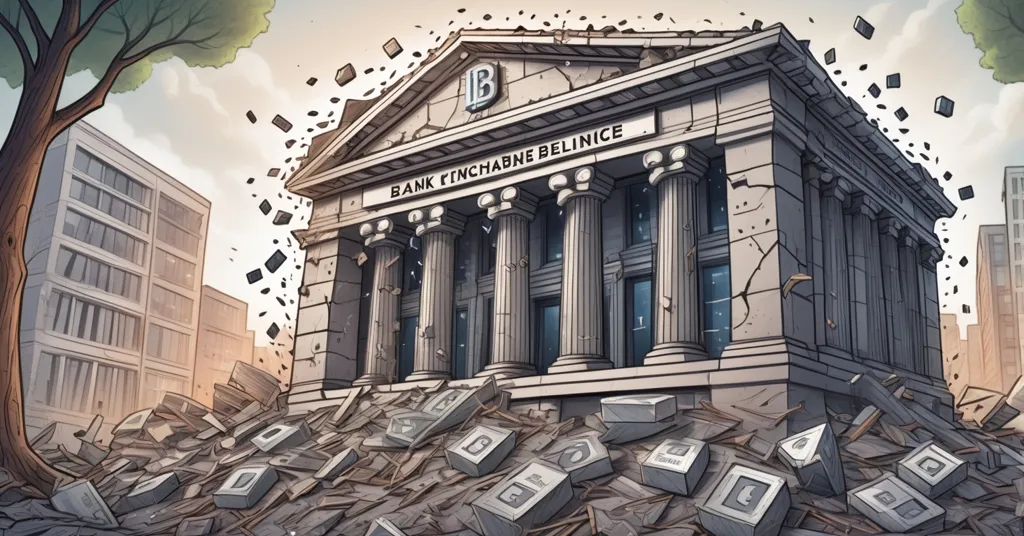Japanese Hedge Fund Collapse Sparks Blockchain’s Role in Financial Resilience

When the East Buckled, Blockchain Whispered
What happens when a respected financial institution crumbles under pressure? The collapse of a Japanese hedge fund on April 8, 2025, due to a risky investment strategy, underscores the urgent need for blockchain technology to enhance financial resilience and transparency.
- Japanese hedge fund collapses from over-leverage
- Trump’s tariffs spark global market turmoil
- Blockchain’s potential to fortify financial systems
- Contrasting Western and Eastern blockchain strategies
The financial world was rocked when a Japanese hedge fund collapsed under the weight of a 60x leveraged position in U.S. Treasury bonds. This isn’t just Wall Street jargon; it means the fund borrowed heavily, betting big on what they believed were safe assets. But when Trump announced revived tariffs on April 2, 2025, the markets turned volatile. Imagine betting your entire house on a game of roulette, only for the wheel to suddenly change its rules. That’s what happened to the fund, triggering a cascade sell-off in Treasuries and a sharp rise in Japanese 30-year yields.
The global financial system is like a house of cards—beautiful but fragile. George Siosi Samuels, managing director at Faiā, put it bluntly, “If the global financial plumbing can buckle under legacy assumptions, then maybe ‘blockchain for auditability’ isn’t a side quest. It’s survival infrastructure.” In other words, if traditional systems can fail this spectacularly, blockchain might be our lifeline.
While the West focuses on on-chain accountability, the East is taking a different approach. In the West, enterprises are likely to ramp up efforts to tokenize treasuries—think of it as turning government bonds into digital tokens on a blockchain. They’ll also use smart contracts, which are like digital contracts that automatically enforce their terms, to set limits on leverage. Auditable risk registries, a fancy term for a transparent list of risks, will also become more common. These measures aim to inject transparency and control into what has been a murky world.
Meanwhile, in the East, the focus is on risk transparency and regional financial sovereignty. They’re speeding up public-private collaborations on distributed ledger technology (DLT)—think of it as a shared database that everyone can see and trust. Projects like mBridge, a multi-currency blockchain settlement system, and digital trade corridors backed by the Regional Comprehensive Economic Partnership (RCEP) are gaining steam. These initiatives not only aim to enhance regional trade but also to build a bulwark against global financial shocks.
The broader implications of this collapse are like a wake-up call. Even the safest assets can be rocked by global turbulence. It’s a stark reminder that our financial systems are vulnerable and that we need new solutions. Blockchain technology, with its promise of programmable trust, distributed oversight, and real-time calibration, is emerging as a beacon of hope. As Samuels noted, “Blockchain isn’t here to save the system. It’s here to show us where it’s broken—and build what comes next.”
Despite Trump’s 90-day tariff suspension on April 9, 2025, the human impact of these events remains significant. Layoffs and rising prices have hit workers and consumers hard, emphasizing the need for stable and resilient financial systems. The growing use of stablecoins—digital currencies pegged to traditional assets like the dollar—and compliance tools like Sentinel are testament to blockchain’s role in enhancing accountability and protecting users.
Blockchain isn’t here to save the day like a superhero, but it sure can point out where the system’s cape is tangled. It’s like a digital ledger that’s as transparent as a public bulletin board but as secure as a bank vault. And while we’re all for decentralization and disrupting the status quo, let’s not forget the challenges. Blockchain isn’t a magic bullet; it has its own hurdles, like scalability and regulatory uncertainty. But if we can navigate these, we might just build a more robust financial future.
Key Takeaways and Questions
- What caused the Japanese hedge fund to collapse?
The collapse was triggered by a 60x leveraged position in 10-year U.S. Treasury bonds, which became unsustainable due to Trump’s tariff announcements causing market volatility.
- How might Western enterprises respond to this event?
Western enterprises are likely to increase the use of blockchain for on-chain accountability, including tokenized treasuries, smart-contract-driven leverage thresholds, and auditable risk registries.
- What steps might the East take following this incident?
The East may accelerate public-private DLT collaborations for better risk transparency and pursue regional financial sovereignty through projects like mBridge and RCEP-backed digital trade corridors.
- What broader insights does this event provide about the global financial system?
It reveals that even the world’s most secure assets are not immune to global shocks, and traditional financial systems are vulnerable, highlighting the need for new solutions like blockchain for resilience.
- What is the role of blockchain in the current financial landscape?
Blockchain is seen as a tool to identify where the financial system is broken and to build more resilient and transparent structures, offering programmable trust, distributed oversight, and real-time calibration.
In a world where financial institutions can crumble like sandcastles, the promise of blockchain grows louder. As we navigate the unpredictable seas of global finance, we must embrace both the potential and the challenges of this technology. It’s not just about saving the system; it’s about building a better one.



